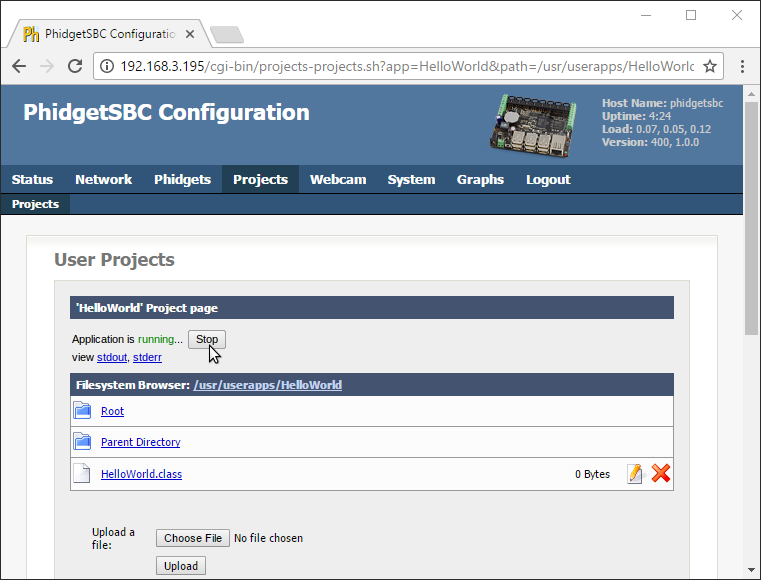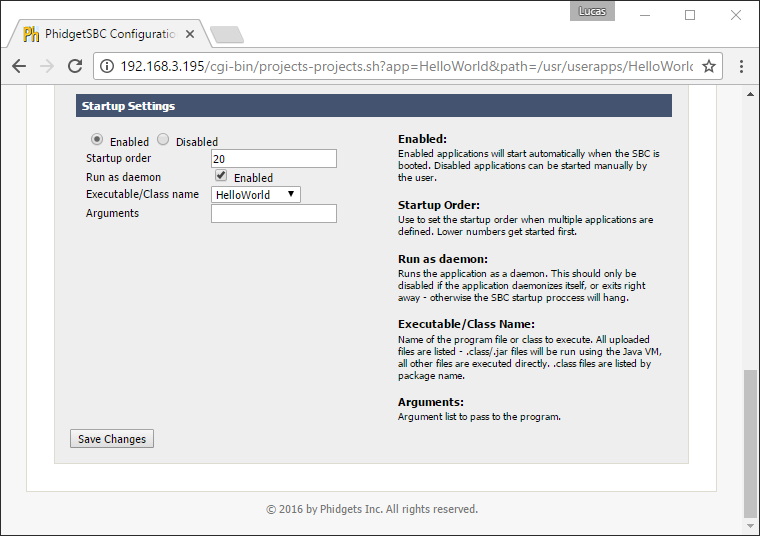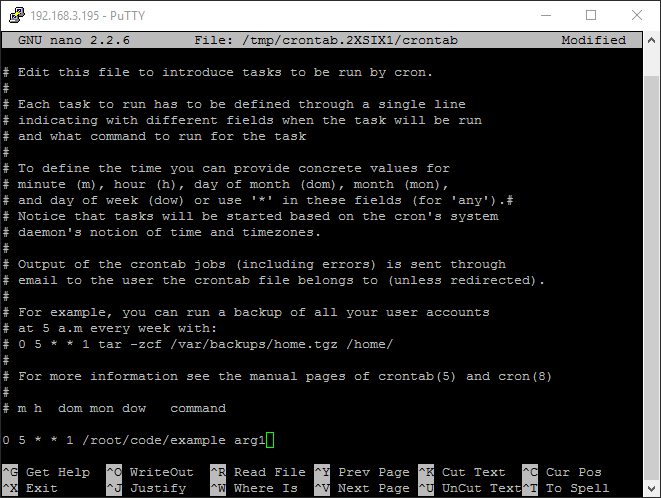|
|
| (230 intermediate revisions by 10 users not shown) |
| Line 1: |
Line 1: |
| [[File:icon-Java.png|64x64px|link=Language - C Sharp]]Java is a modern, object-oriented programming language developed by Oracle. | | [[Category:Language]] |
| | __NOTOC__ |
|
| |
|
| __TOC__
| | We provide support for the Java language in all major operating systems. We also provide instructions on how to get your project started in a number of common development environments. Select your operating system and preferred development environment below, and follow the instructions to get your project running with Phidgets. |
|
| |
|
| ==Introduction==
| | If you do not know which development environment you want to use, or your development environment of choice is not listed, we recommend starting with javac as the simplest path to getting your code running. |
|
| |
|
| {{LanguageSupport|Java|the complete Phidget API, including events|all Phidget devices.|various environments such as <code>javac</code>, NetBeans, and Eclipse}}
| | Once you have set up your development environment to run with Phidgets, we recommend you follow our guide on [[Phidget Programming Basics]]. The guide will showcase the fundamentals of programming with Phidgets, with examples in Java. |
|
| |
|
| ==Quick Downloads== | | == Setup Guide == |
|
| |
|
| Just need the Java drivers, libraries, and examples? Here they are:
| | <div class="phd-deck-sequence"> |
| | {{PT3_JAVA_CHOOSE}}{{PT3_JAVA_WIN_JAVAC}}{{PT3_JAVA_MAC_JAVAC}}{{PT3_JAVA_LNX_JAVAC}}{{PT3_JAVA_SBC_JAVAC}}{{PT3_JAVA_WIN_NETBEANS}}{{PT3_JAVA_MAC_NETBEANS}}{{PT3_JAVA_LNX_NETBEANS}}{{PT3_JAVA_WIN_ECLIPSE}}{{PT3_JAVA_MAC_ECLIPSE}}{{PT3_JAVA_LNX_ECLIPSE}}{{PT3_JAVA_ANDROID_AS}} |
| | </div> |
|
| |
|
| Java API Documentation:
| | == Quick Downloads == |
| *[http://www.phidgets.com/documentation/JavaDoc.zip Java API Manual Download] or [http://www.phidgets.com/documentation/web/javadoc/index.html (HTML online version)]
| |
| *[[General API]] (more help on functions common to all Phidgets)
| |
| *[[Device List | Device Specific APIs]] (more help on functions specific to your Phidget)
| |
|
| |
|
| Java Example Code:
| | If you already know what you're doing and just need the files, you can find them all below. |
|
| |
|
| *[http://www.phidgets.com/downloads/examples/JavaJNI_2.1.8.20111220.zip Java Example Code]
| | === Documentation === |
|
| |
|
| Libraries and Drivers:
| | *{{Phidget22API}} (select Java from the drop-down menu) |
| *[http://www.phidgets.com/downloads/libraries/phidget21jar_2.1.8.20111220.zip phidget21.jar] | |
| *[http://www.phidgets.com/downloads/libraries/Phidget-x86_2.1.8.20111220.exe 32 bit Windows (drivers, with libraries)]
| |
| *[http://www.phidgets.com/downloads/libraries/Phidget-x64_2.1.8.20111220.exe 64 bit Windows (drivers, with libraries)]
| |
| *[http://www.phidgets.com/downloads/libraries/libphidget_2.1.8.20111028.tar.gz General Linux Libraries] ([[OS - Linux | Linux Library Setup Instructions]])
| |
| *[http://www.phidgets.com/downloads/libraries/Phidget_2.1.8.20111103.dmg General Mac OSX Libraries] ([[OS - Mac OS X | Mac OS X Library Setup Instructions]])
| |
|
| |
|
| ==Getting started with Java== | | === Example Code === |
|
| |
|
| If you are new to writing code for Phidgets, we recommend starting by running, then modifying existing examples. This will allow you to:
| | *{{SampleCode|Java|Java Examples}} |
| {{ExampleCodeReasons}} | |
| | |
| Instructions are divided up by operating system. Choose:
| |
| *[[#Windows(2000/XP/Vista/7)|Windows 2000 / XP / Vista / 7]]
| |
| *[[#Mac OS X |Mac OS X]]
| |
| *[[#Linux | Linux]] (including PhidgetSBC)
| |
| | |
| ==Windows(2000/XP/Vista/7)==
| |
|
| |
|
| ===Libraries=== | | ===Libraries=== |
| *[http://www.phidgets.com/downloads/libraries/phidget21jar_2.1.8.20111220.zip phidget21.jar]
| |
|
| |
| ===Description===
| |
| Java programs on Windows depend on the following files, which the installers above put onto your system:
| |
| * <b><code>phidget21.dll</code></b> contains the actual Phidgets library, which is used at run-time. If you used our installer, it's already correctly placed in <code>C:\Windows\System32</code>. It can be manually installed - check our [[Manual Installation instructions]].
| |
| You will also need one of the following two files, depending on the .NET framework version you are targeting:
| |
| * <b><code>phidget21.jar</code></b> is the Phidgets library for JDK <i><b>1.4.2</b></i> or higher. Your compiler has to know where this file is. By default, our installer puts this file into <code>C:\Program Files\Phidgets</code>. So, you can either point your compiler to that location, or copy and link to it in a directory for your project workspace. For more information, please see the section for your specific compiler/environment. If you do not want to use our installer, you can get the file [[#Libraries | here]].
| |
|
| |
| Running the examples and writing your own code can be fairly compiler-specific, so we include instructions for each compiler below.
| |
|
| |
| ===Java===
| |
|
| |
| This section will provide instructions on how to compile using the <code>javac</code> compiler. Start by downloading the Java Examples.
| |
| *[http://www.phidgets.com/downloads/examples/JavaJNI_2.1.8.20111220.zip Java Examples]
| |
|
| |
| =====Use Our Examples=====
| |
|
| |
| Download the examples [[#Java|from above]] and unpack them into a folder. Here, you can find example programs for all the devices. If you aren't sure what the software example for your device is called, check the software object listed in the [[Device List | Getting Started guide for your device]]. Please only use the simple examples.
| |
| <br/>
| |
| Ensure that the <code>phidget21.jar</code> is in the same directory as the source code.
| |
|
| |
| To compile:
| |
| <br/>[[File:Java Compile.PNG]]<br/>
| |
|
| |
| This will create Java bytecode in the form of <code>.class</code> files. Type the following to run the program:
| |
| <br/>[[File:Java Run.PNG]]<br/>
| |
|
| |
|
| |
| If you wish, you can compile the project as a <code>.jar</code> so there are fewer files to maintain. The [[http://www.oracle.com/java Java SDK]] provides the <code>jar</code> utility which packages all the <code>.class</code> files into a single <code>.jar</code> file.
| |
| To begin, you will have to provide a Manifest file to indicate the program entry point. With your favourite text editor, create a new file with the following content:
| |
| Manifest-Version: 1.0
| |
| Class-Path: phidget21.jar
| |
| Main-Class: example
| |
|
| |
| Ensure that the file ends in a new line or a carriage return.
| |
| Save the file as <code>example.mf</code> and place it in the same directory as the other <code>.class</code> files.
| |
| Next, create the .<code>jar</code> with:
| |
|
| |
| [[File:Java Create Jar.PNG]]<br/>
| |
|
| |
| Afterwards, you can run the <code>.jar</code> with:
| |
|
| |
| [[File:Java Create Run Jar.PNG]]<br/>
| |
|
| |
| Once you have the Java examples running, we have a [[#Follow The Examples|teaching section]] below to help you follow them.
| |
|
| |
| =====Write Your Own Code=====
| |
|
| |
| When you are building a project from scratch, or adding Phidget function calls to an existing project, you'll need to configure your compiler / development environment to properly link the Phidget Java libraries. Please see the [[#Use Our Examples 3 | previous section]] for instructions.
| |
|
| |
| In your code, you will need to include the Phidget library:
| |
|
| |
| <div style="background-color: #f3f3f3; border-color: #1c9edb; border-width:1px; border-style: dashed;">
| |
| <font size="3">
| |
| <source lang=java>
| |
| import com.phidgets.*;
| |
| import com.phidgets.event.*;
| |
| </source>
| |
| </font>
| |
| </div>
| |
|
| |
| The project now has access to the Phidget21 function calls and you are ready to begin coding.
| |
|
| |
| The same [[#Follow The Examples|teaching section]] which describes the examples also has further resources for programming your Phidget.
| |
|
| |
| ===NetBeans===
| |
|
| |
| Please start by downloading the Java Examples. The full examples were written in NetBeans, so the rest of this section will use these examples. To use the simple examples, you will have to import the source code into a new NetBeans project.
| |
|
| |
| *[http://www.phidgets.com/downloads/examples/JavaJNI_2.1.8.20111220.zip Java Examples]
| |
|
| |
| =====Use Our Examples=====
| |
|
| |
| To run the examples, you first download them [[#NetBeans|from above]], unpack them into a folder, and then find the source code for your device. The source file will be named the same as the software object for your device. If you aren't sure what the software example for your device is called, check the software object listed in the [[Device List | Getting Started guide for your device]].
| |
|
| |
| [[File:Java NetBeans Open Project.PNG]]
| |
|
| |
| The only thing left to do is to run the examples! Click on Run | Run Project. Please note that the project, by default tries to find the <code>phidget21.jar</code> in <code>C:\Program Files\Phidgets</code>. If you have it installed in another location, please change the path accordingly. Please see the next section for more details.
| |
| <br/><br/>
| |
| [[File:Java NetBeans Run.PNG]]
| |
| <br/><br/>
| |
| Once you have the Java examples running, we have a [[#Follow The Examples|teaching section]] below to help you follow them.
| |
|
| |
| =====Write Your Own Code=====
| |
|
| |
| When you are building a project from scratch, or adding Phidget function calls to an existing project, you'll need to configure your compiler / development environment to properly link the Phidget Java libraries. To begin:
| |
|
| |
| * Create a new Java application project with a descriptive name such as PhidgetTest.
| |
| <br/>[[File:Java NetBeans New Project.PNG]]
| |
|
| |
| <br/>
| |
|
| |
| * Add a reference to the Java Phidgets library. In the projects pane, right click <code>Libraries</code> and add the jar.
| |
| <br/>[[File:Java NetBeans Add Jar.PNG]]<br/>
| |
| * Find and select <code>phidget21.jar</code> If you used our installer, it is in <code>C:\Program Files\Phidgets</code>.
| |
| <br/>[[File:Java NetBeans Add Jar 2.PNG]]<br/><br/>
| |
|
| |
| Then, in your code, you will need to include the Phidget library:
| |
|
| |
| <div style="background-color: #f3f3f3; border-color: #1c9edb; border-width:1px; border-style: dashed;">
| |
| <font size="3">
| |
| <source lang=java>
| |
| import com.phidgets.*;
| |
| import com.phidgets.event.*;
| |
| </source>
| |
| </font>
| |
| </div>
| |
|
| |
| The project now has access to the Phidget21 function calls and you are ready to begin coding.
| |
|
| |
| The same [[#Follow The Examples|teaching section]] which describes the examples also has further resources for programming your Phidget.
| |
|
| |
| ===Eclipse===
| |
|
| |
| Start by downloading the Java Examples.
| |
| *[http://www.phidgets.com/downloads/examples/JavaJNI_2.1.8.20111220.zip Java Eamples]
| |
|
| |
| =====Use Our Examples=====
| |
|
| |
| Download the examples [[#Eclipse|from above]] and unpack them into a folder. Here, you can find example programs for all the devices. If you aren't sure what the software example for your device is called, check the software object listed in the [[Device List | Getting Started guide for your device]]. Please use the simple examples. The full examples were written in NetBeans, and are not compatible with Eclipse. The rest of this guide will assume that the simple examples are used. You will the example source code to be copied into your Eclipse project later on. Keep note of the file name of the example as a Java class will be created with the same name.
| |
| <br/>
| |
|
| |
| * Generate a new Java project with a descriptive name such as PhidgetTest.
| |
| <br/>[[File:Java Eclipse New Project.PNG]]<br/>
| |
| <br/>
| |
| * On the next screen, go to the libraries panel and add an external jar.
| |
| <br/>[[File:Java Eclipse Add Jar 1.PNG]]<br/>
| |
|
| |
|
| |
| * Find and select <code>phidget21.jar</code>. If you used our installer, by default, this file is placed in <code>C:\Program Files\Phidgets</code>. If it is in another location, please change the path accordingly.
| |
| <br/>[[File:Java Eclipse Add Jar 2.PNG]]<br/>
| |
|
| |
|
| |
| * Add a new Java class to the project.
| |
| <br/>[[File:Java Eclipse New Class.PNG]]<br/>
| |
|
| |
|
| |
| * Name this class with the same name as the simple example's name.
| |
| <br/>[[File:Java Eclipse New Class 2.PNG]]<br/>
| |
|
| |
|
| |
| * Copy and paste the example source code over to the class you created.
| |
| <br/>[[File:Java Eclipse Source.PNG]]<br/>
| |
|
| |
|
| |
| The only thing left to do is to run the examples!
| |
|
| |
| <br/>[[File:Java Eclipse Run.PNG]]<br/>
| |
|
| |
|
| |
| Once you have the Java examples running, we have a [[#Follow The Examples|teaching section]] below to help you follow them.
| |
|
| |
| =====Write Your Own Code=====
| |
|
| |
| When you are building a project from scratch, or adding Phidget function calls to an existing project, you'll need to configure your compiler / development environment to properly link the Phidget Java libraries. Please see the previous section for instructions.
| |
|
| |
| In your code, you will need to include the Phidget library:
| |
|
| |
| <div style="background-color: #f3f3f3; border-color: #1c9edb; border-width:1px; border-style: dashed;">
| |
| <font size="3">
| |
| <source lang=java>
| |
| import com.phidgets.*;
| |
| import com.phidgets.event.*;
| |
| </source>
| |
| </font>
| |
| </div>
| |
|
| |
| The project now has access to the Phidget21 function calls and you are ready to begin coding.
| |
|
| |
| The same [[#Follow The Examples|teaching section]] which describes the examples also has further resources for programming your Phidget.
| |
|
| |
| ==Mac OS X==
| |
|
| |
| C# has excellent support on Mac OS X through the Mono framework.
| |
|
| |
| The first step in using C# on Mac is to install the Phidget libraries. Compile and install them as explained on the [[Device List|getting started guide for your device]]. Then, the [[OS - Mac OS X]] page also describes the different Phidget files, their installed locations, and their roles....
| |
|
| |
| ==Linux==
| |
|
| |
| C# has support on Linux through the Mono framework.
| |
|
| |
| The first step in using C# on Linux is to install the Phidget libraries. Compile and install them as explained on the main [[OS - Linux | Linux page]]. That Linux page also describes the different Phidget files, their installed locations, and their roles.
| |
|
| |
| ==Follow The Examples==
| |
|
| |
| By following the instructions for your operating system and compiler above, you probably now have a working example and want to understand it better so you can change it to do what you want. This teaching section has resources for you to learn from the examples and write your own.
| |
|
| |
| Next, comes our API information. These resources outline the C# Phidget functions:
| |
|
| |
| {{UsingAPhidgetInCodeGeneral|both of which are available in C#|[http://www.phidgets.com/documentation/Phidget21.NET.zip C# API]}}
| |
|
| |
| ===Example Flow===
| |
|
| |
| {{ExamplePseudocode|In Java, you can name these '''event''' functions whatever you like. You will then pass them as function pointers to the Phidget library below in the Main Code section. This hooks them into the actual events when they occur. <br>
| |
| In the example code, the event functions common to all Phidgets are called things like '''AttachHandler()''' and '''DetachHandler()''', etc.<br><br>
| |
| Some event functions will be specific to each device, like when a tag is read on an RFID board, or when a sensor value changes on an Interface Kit.
| |
| Other functions are given in the examples to show you more detail on using your Phidget. For example, '''DeviceInitialize()''' will show what needs to be set up for your Phidget before using it.
| |
| |Creating a Phidget software object in Java is specific to the Phidget. For a Phidget Spatial, for example, this would involve creating a <code>SpatialPhidget</code> object. The examples show how to do this and other API functions.<br><br>
| |
| The object provides device specific methods and properties which are available from the API for your specific Phidget.|
| |
| [http://www.phidgets.com/documentation/JavaDoc.zip Java API]}}
| |
|
| |
| ==Common Problems and Solutions/Workarounds==
| |
|
| |
|
| Here you can put various frequent problems and our recommended solutions.
| | *[https://cdn.phidgets.com/downloads/phidget22/libraries/any/Phidget22Java.zip phidget22.jar] |
| | {{AllQuickDownloads}} |




